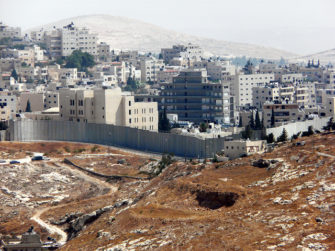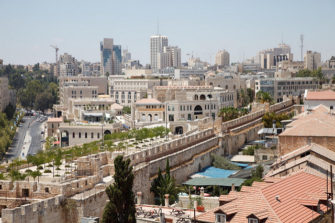
Like many Jews around the world, every morning I engage in a somewhat arcane ritual of placing leather boxes on my forehead and arm containing scriptural verses handwritten carefully by a scribe and, among other things, I pray for the flourishing of Jerusalem. And quite often, along with many Jews, Christians, Muslims, and others, I hope for a peaceful resolution to the conflict of Israel/Palestine, including Jerusalem. Am I praying and hoping for the same thing? Is praying and hoping the same thing? The same Jerusalem?
After the Six-Day War in 1967 Israeli poet Naomi Shemer wrote a song entitled “Jerusalem of Gold” celebrating the beauty of a city that many Israelis and Jews considered “liberated” and “unified.” Songs, like poems, are more often aspirational than a reflection of a messy political reality. “Jerusalem of Gold” became a classic. But what Jerusalem does it represent? Whose Jerusalem does it represent?
From 1948 until 1967 Jerusalem was truly a divided city; the western half part of Israel, the eastern half part of Jordan. The Six-Day War did not unify the city; in some way it re-instated its divided status, putting both halves, still divided, under one sovereign. There are segregated cities and divided cities. Boston in the 1960s and 1970s was largely a segregated city. Jerusalem is a divided one. East and west today have separate bus systems, school systems, separate sanitation collection, even separate mail delivery systems. Western Jerusalem is a Jewish city, eastern Jerusalem a Muslim city; in the west the lingua franca is Hebrew, in the east, Arabic. Those in the west, most of whom are relative newcomers but view the city as the fulfillment of their religious and national aspirations, largely see the city as theirs, those in the east, many of whose families have lived in Jerusalem for generations, see it as theirs. The illusion of a unified city in Shemer’s “Jerusalem of Gold” is just that; an illusion. That is, if we understand the question of unity to be more complex than simply power. In the real world, west Jerusalem is the capital of Israel; east Jerusalem is a city in waiting. Jerusalem the holy city is in exile.

From the halls of the Israeli Parliament to the fresh cut lawns of American Jewish summer camps, one hears the refrain that Jerusalem is the capital of “the Jewish people.” This is an interesting assertion. First, as my colleague Liora Halperin noted in a Facebook post, the Jewish people do not have a capital because the Jewish people are not a nation-state. Israel is not the state of the Jewish People, even if you maintain it is a Jewish state, largely because about half of the world’s Jews choose not to live there. Like every nation-state, Israel is state of its citizens. Second, Jerusalem is certainly the holiest site of the Jewish people, the center of its homeland, and the place of its longing. But as Hannah Arendt noted in her 1947 essay “To Save the Jewish Homeland,” a homeland is not a state and, in fact, a state may undermine a homeland. Homelands too are aspirational, states by definition often destroy aspirations. As Franz Rosenzweig suggested, homelands, or holy lands, are places of longing. In states longing too often is buried in the messiness of injustice and inequality. Finally, Jerusalem in the Jewish imagination was not limited to a place, much less a state, but also traditionally functioned as a marker of robust Jewish life in the Diaspora. Thus Vilna was called “The Jerusalem of Lithuania,” and Lublin “The Jerusalem of Poland,” etc. If you look at the “real” Jerusalem, the city behind the theology, which is, as Israeli poet Yehudah Amichai so pointedly put in his poem, “Tourists,” the place where “A man buys fruits and vegetables for his family,” Jerusalem is a divided city where a significant portion of its inhabitants (not of all whom are even citizens) do not even recognize the sovereignty which that capital represents.
What drives the rhetoric of “Jerusalem as the eternal capital of Israel” is the erasure of a divide separating aspirational theology and Realpolitik. In his 1922 Political Theology, Carl Schmitt argued that modern politics is little more than secularized forms of pre-modern theological precepts. Is Jerusalem a proof of his theory, or an exception? I suggest the latter. The sleight of hand in Schmitt’s thinking is the way secularism serves as a veil, a rational frame that conceals non-rational motives driven by claims founded on theological beliefs. In some way, Zionism may confirm such a theory. Even some of the most secular architects of Zionism claimed that Zionism contains elements of messianism, broadly defined, without which it could not sustain its force or popular appeal. But Jerusalem might be different because in the case of Jerusalem, for Jews at least, the secular veil is not even translucent, it is transparent. It hides nothing. And yet it is precisely in this transparency and in the very claim of Jerusalem’s unification, that the vulnerable underbelly of Jerusalem is exposed; the erasure of any difference between prayer, and hope, between theologically-based aspirations and the workings of modern statecraft. Israel is not a theocracy, but it, and Jerusalem in particular, is too often theologically justified.
This came through quite clearly in Shmuel Rosner’s recent op-ed in the New York Times “Of Course Jerusalem is Israel’s Capital” (December 5, 2017). Rosner begins with a discussion about the Jerusalem Temple destroyed over 2,000 years ago and the conclusion of the Passover Seder “Next Year in Jerusalem” as “proof” of Jerusalem as the capital of modern-day Israel. What Rosner doesn’t mention is that the rabbinic tradition relegates the rebuilding of the Temple and collective return of the Jews to the messianic age, which Jews believe is still forthcoming. Nor does he mention that the aspiration “Next Year in Jerusalem” is theological rather than political: Jews celebrating Passover and Yom Kippur in Jerusalem also say “Next Year in Jerusalem” (some say “the re-built Jerusalem”).
It is not insignificant that the 1947 U.N. Partition Plan that created the state of Israel and is so often used by pro-Israelis to justify its international status establishes Jerusalem as an “international regime…to be administered by the United Nations Trusteeship Council.” This declaration was made with full knowledge of the complexity of Jerusalem and perhaps recognition of the inability to disentangle it from its theological and aspirational status, at least in the initial stages of statecraft.

This nuance seemed lost in President Trump’s declaration of Jerusalem as the capital of Israel. But such nuance was understood quite well by the likes of Shmuel Rosner and Prime Minister Netanyahu. For Rosner it fortified the permanent erasure of theology and politics and in doing so made the former a handmaiden to the latter. The danger here is that when there is no distinction between prayer and hope, between an aspirational Jerusalem and a divided city, God becomes no more than a means to human power and religion a Machiavellian church. For Prime Minister Netanyahu the primary victory is the erasure of “east” and “west” thereby “unifying” a city not through collective bargaining but by the political will of a global power. In this sense, Jerusalem is now under the sovereignty of the United States. What the Prime Minister gets in return is a case against a Palestinian State since he knows that the Palestinians would never, and arguably should never, accept a state that does not have (east) Jerusalem as its capital. Shortly before his death, Netanyahu’s father Ben Zion Netanyahu responded to the question as to whether his son favors a Palestinian State. The elder Netanyahu responded “He supports the kind of conditions they would never in the world accept.” President Trump has arguably just confirmed Ben Zion Netanyahu’s prediction.
But if we move beyond the power politics and return to those morning prayers and afternoon hopes, to Schmitt’s claim about politics and to Jerusalem’s sacred status, we can ask whether using God to rule over others is actually antithetical to praying to God to redeem the world. My point is not to sink into some kind of sentimental piety. Rather it is to suggest that Jerusalem—both aspirational and real—is a great way to enter into the mosh pit of religion and politics, a great counter example to Schmitt that affirms his principle while challenging his assessment of the secular. Jerusalem is theology all the way down, and Trump just affirmed that this is sufficient to undermine the contemporary Palestinian narrative and make a geo-political claim of ownership. In this sense, Trump’s declaration is certainly Schmittean.
But if we want to take theology in another direction then we might suggest the very opposite of what has transpired. One of history’s great purveyors of Jerusalem is, of course, the prophet Isaiah. Isaiah prophesied,
Even them will I bring to My holy mountain, And make them joyful in My house of prayer; Their burnt-offerings and their sacrifices Shall be acceptable upon Mine altar; For My house shall be called A house of prayer for all peoples (Is. 56:7).
Rosner’s inclusion of the Jerusalem Temple only goes half way. If it’s the Temple upon which Jerusalem is based (and that is how Rosner begins his op-ed) then it is not about sovereignty, certainly not only about sovereignty, it is also, perhaps primarily, about inclusivity. This is the prayer. And the hope.
In the 1980s Zalman Schachter-Shalomi, architect of the Jewish Renewal movement penned an “Open Letter to Teddy Kollek,” then mayor of Jerusalem. In his letter he made the case for the internationalization of Jerusalem as an expression of aspiration where prayer and hope could co-exist. For Jerusalem to be truly “unified” it should be “internationalized.” This kind of unification is the submission of human sovereignty to that which lies beyond, or inside, it. Not using theology as a handmaiden of human power but human power as a handmaiden of theology. Where theology could serve a humanizing function, what Martin Buber called “Hebrew Humanism.”
The tragedy in President Trump’s Jerusalem decision is that its ostensible obviousness belies its destructive potential, and not only in regards to violent protest or political fallout. Rather, it undermines the sacrality of Jerusalem for three religions, essentially relegating it only to one. As Isaiah saw it, that exclusivity undermines Jerusalem’s sacredness. As a lover of gold, Trump has inadvertently undermined Shemer’s song and given us a cheaper version: a gold-plated Jerusalem. Shemer saw a vision of the future even though it was still an illusion; Trump abandoned any spiritual vision for the cheaper shininess of the now.
I affirm all Judaism’s religious claims to Jerusalem. And I affirm all Islam’s religious claims to Jerusalem. And Christian claims. And I reject all of them as leverage to the modern secular nation-state called Israel. I can live with my prayer and my hope as having two separate objects. Jerusalem, a city divided, and the Jerusalem that aspires one day to be unified. But I can only tolerate the “unification” of my prayer and my hope if such unification maintains the object of my prayer as an integral part of the object of my hope. The U.N. Partition Plan made “internationalization” an exercise in pragmatism. They likely did not have Isaiah 56 in mind. But I do. And it is my prayer and my hope that moving forward, Isaiah’s words will once again be heard from the City of Peace, not as a triumphalist claim of sovereignty but as a true call for “unification.” Only then can the holy city of Jerusalem truly be a capital of anything.

